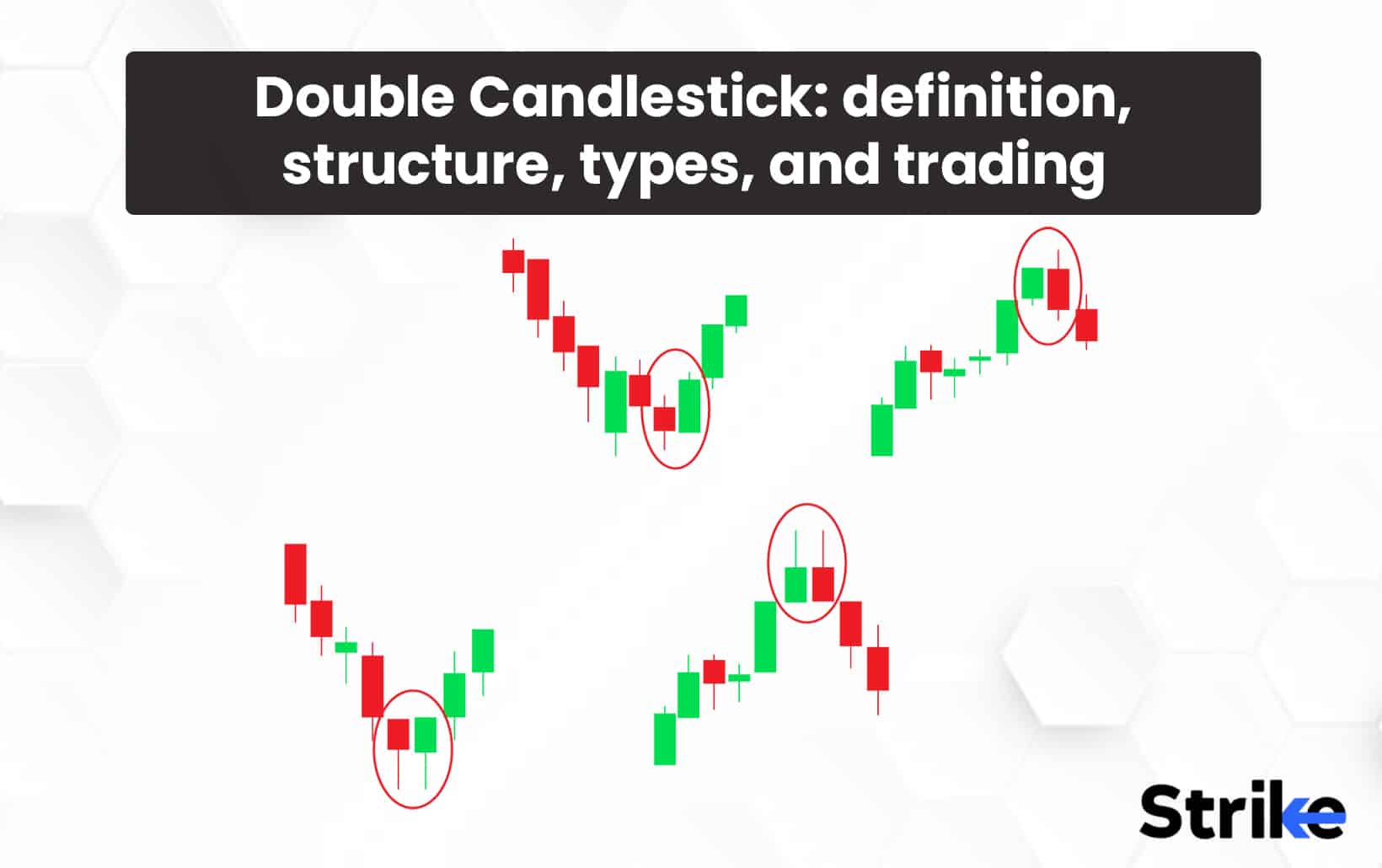
Double candlesticks are made up of two consecutive candlesticks that provide information about the market’s sentiment and direction. Double candlestick patterns are identified based on the relationship between the two candlesticks such as the size of their bodies, the direction of their shadows, and their placement relative to support and resistance levels.
The first candlestick is known as a “signal candle’’, and it provides the direction of the market. The second candle stick is known as the “confirmation candle”. The pattern is a combination of two candlesticks that form together, used in technical analysis to predict the direction in which the price of an asset is to move in the future.
The basic type of double candlestick formation is the bullish engulfing pattern. The engulfing pattern occurs at the end of the market trend with the setup candle showing signs of exhaustion and the confirmation candle indicate a complete takeover. The main double candlestick patterns are of two types: bullish and bearish patterns.
Each pattern has its own characteristics and provides better insights into the market trends and about price alterations. Double candlestick is an essential tool for identifying potential reversals or the continuation of a trend. It is important to confirm the trend before making a trend, as these are more common when they occur after a downtrend for suggesting a potential reversal.
Traders consider the overall market context when interpreting double candlesticks factors such as the volume, volatility, and general sentiment of the market which will affect the reliability of the set up. The double candlestick patterns occur on a price chart, it provides strong signals and traders consider incorporating them as a part of their analysis that makes trading decisions.
Traders can make more informed decisions about when to enter or exit positions and can understand how and when to adjust their trading strategies.
What does a double candlestick mean ?
The term ‘Double candlestick’ is used to differentiate the patterns from single candlestick, which are formed by a single candlestick on a candlestick chart. The basic type of double candlestick patterns involve engulfing candles. There are two types of engulfing candles: Bullish Engulfing and Bearish Engulfing.
The Bullish engulfing pattern is a two candlestick reversal pattern that signals a strong move can occur. It happens when a bearish candle is followed by a larger bullish candle. The bullish pattern applies after the period of downtrend. The Bearish engulfing pattern is the opposite of the bullish pattern. This pattern occurs when the bullish candle is followed by a bearish candle that completely engulfs and this applies when there is uptrend.
A Double candlestick is a technical analysis tool that is used to analyze the price movement in the financial market. Double candlesticks are considered as more authentic signals than single candlestick because they need two consecutive candles to form, which provide additional confirmation of the trend.
Traders use these patterns in combination with other technical indicators to make informed trade decisions, but the double candlestick should not be used in isolation to make trade decisions.
How is a double candlestick pattern structured ?
Double candlestick patterns are formed by two adjacent candles on a candlestick chart. First day / First candle is the first candle in the pattern similarly, Second day/ Second candle is the second candle in the pattern. The second day is placed close to the first day and its open and close prices are within the range of the first day price.
The structure of the pattern depends on the specific type of double candlestick pattern. The second day completely engulfs the body of the first day in a bullish engulfing pattern, so the open and close prices are higher than the bearing engulfing pattern. The second day opens lower than the first day’s close, but then closes higher than the midpoint of the first day’s body in the Piercing pattern.
The second day’s body is completely contained within the range of the first day’s body in Harami pattern. Likewise, the pattern structure differs from each other and they all involve two adjacent candles with specific differences in their open, close, low, high prices.
There are mainly 4 steps to identify the double candlestick patterns :
- Identify two candles adjacent to each other in the beginning
- The next step is to check the open, high, low, and close prices of the two candles to determine which type of the double candlestick pattern is being formed.
- Analyze the pattern to determine that it is a valid signal for a potential reversal.
- Always confirm the pattern with other technical analysis tools before making a trading decision, it helps to become aware of fake signals.
Identifying double candlestick patterns need thorough checking of the candlestick chart and confirming it is a very essential step in trade decision making.
What are the different types of double candlestick patterns ?
Double candlestick pattern is a technical analysis pattern formed by two consecutive candlestick on a price chart. There are mainly 10 different types of double candlestick patterns including Bullish and Bearish engulfing pattern, harami pattern, and tweezer pattern. Each pattern has its own specific characteristics and can provide traders with valuable information about the market.
1.Tweezer Tops
Tweezer tops is a type of double candlestick pattern that happens during an uptrend in the market. The tweezer top is made up of two candlesticks of equal highs. A Tweezer top pattern occurs when the highs of two candlesticks occur at almost the same level following an advance with the second candlestick opening at or near the previous day’s high and then closing lower.
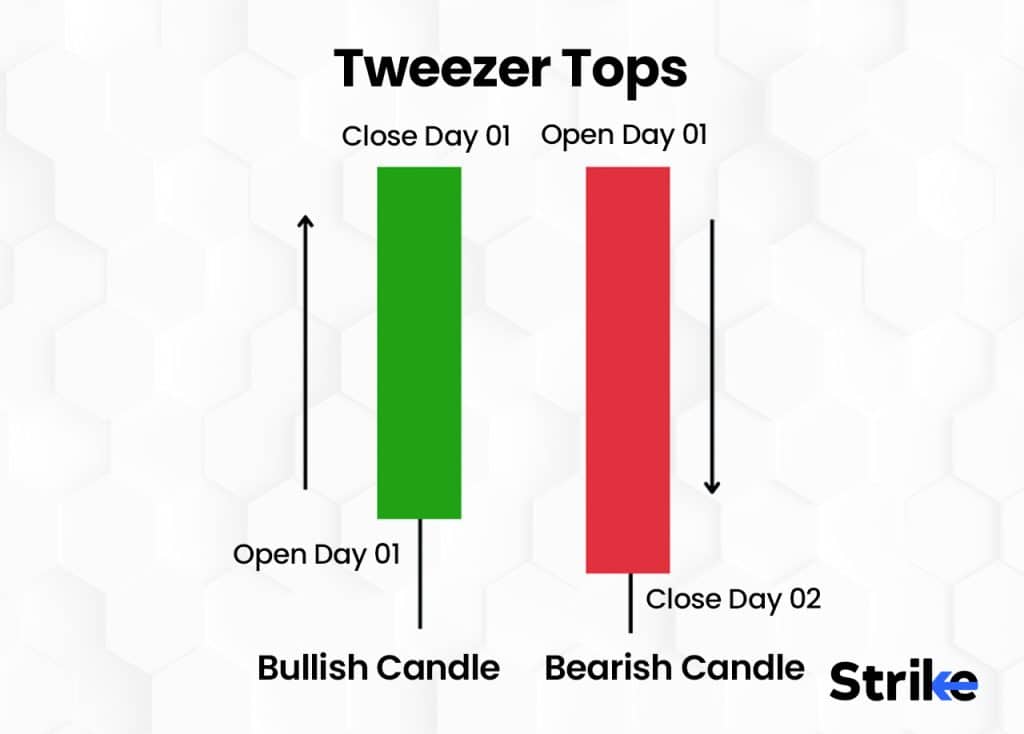
The tweezer top pattern is a bearish reversal signal that the bull will lose the control of the market and a potential trend reversal to the downside occurs. The pattern occurred after a prolonged uptrend it is considered as a more reliable one.
Traders use this pattern to exit a long position or enter a short position, with a stop loss order placed above the high of the second candlestick to limit potential losses. The first candle is bullish but shows rejection of higher prices, and the second candle attempts to surge higher but it fails in the tweezer top. The pattern signals resistance strong and the market will decline and consolidate.
A bullish candlestick should be formed on the first day of its pattern formation and on the next day a bearish candle will form having a similar high of the previous day’s candlestick, if it is a tweezer top pattern. The important feature of the tweezer top is that they have a valid pattern but it looks structurally different from one another.
2.Tweezer Bottoms
The tweezer bottom candlestick is a pattern that occurs on a candlestick chart of a financial instrument. A Tweezer bottom candlestick pattern is a bullish reversal pattern that are spotted at the bottom of a downtrend. The pattern consists of two candles with very similar lows, while the second candlestick is a bullish candlestick with an equal length body and shadow sharing the same low as the first candle.
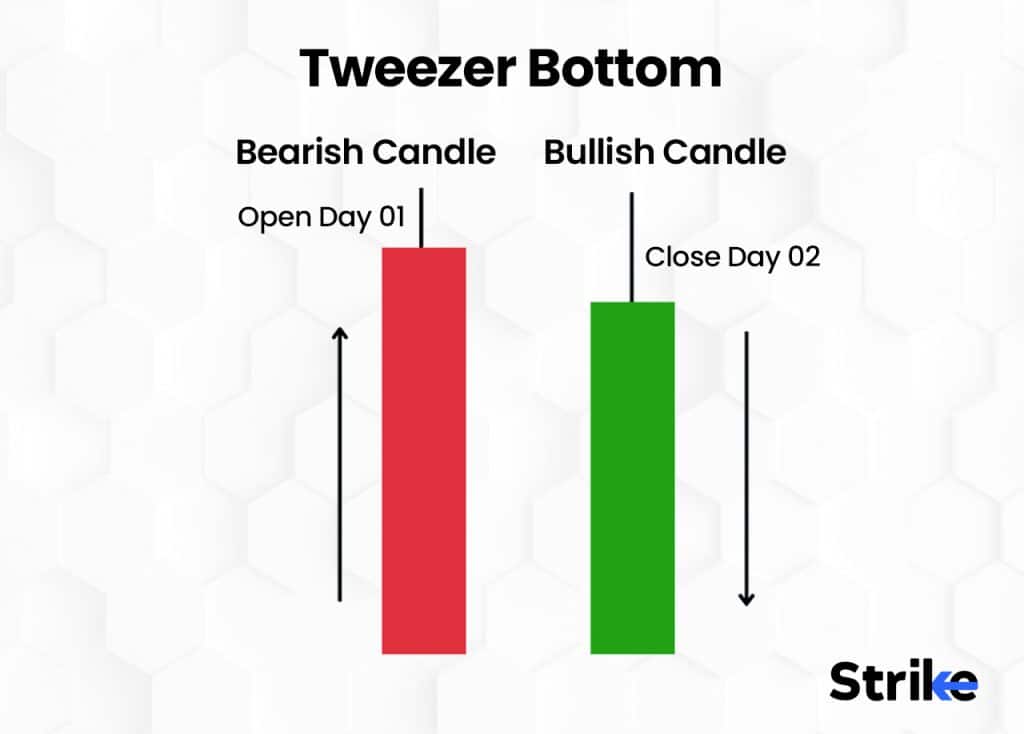
Tweezer bottoms is the opposite of the tweezer tops as it follows extended downtrend. This pattern suggests the selling pressure is exhausted and buyers are starting to take control of the market. A bearish candlestick will form on the first day of the pattern formation and on the next day a bullish candle will form having a similar low of the previous day’s candlestick.
3.Bearish Engulfing Pattern
A Bearish engulfing occurs when a bullish candle is followed by a larger bearish one at the end of an uptrend and it alerts investors to a potential downward rehearsal. The pattern shows lower prices to come in the technical chart. A bearish engulfing pattern consists of an up candlestick followed by a large down candlestick that engulfs the smaller up candle.
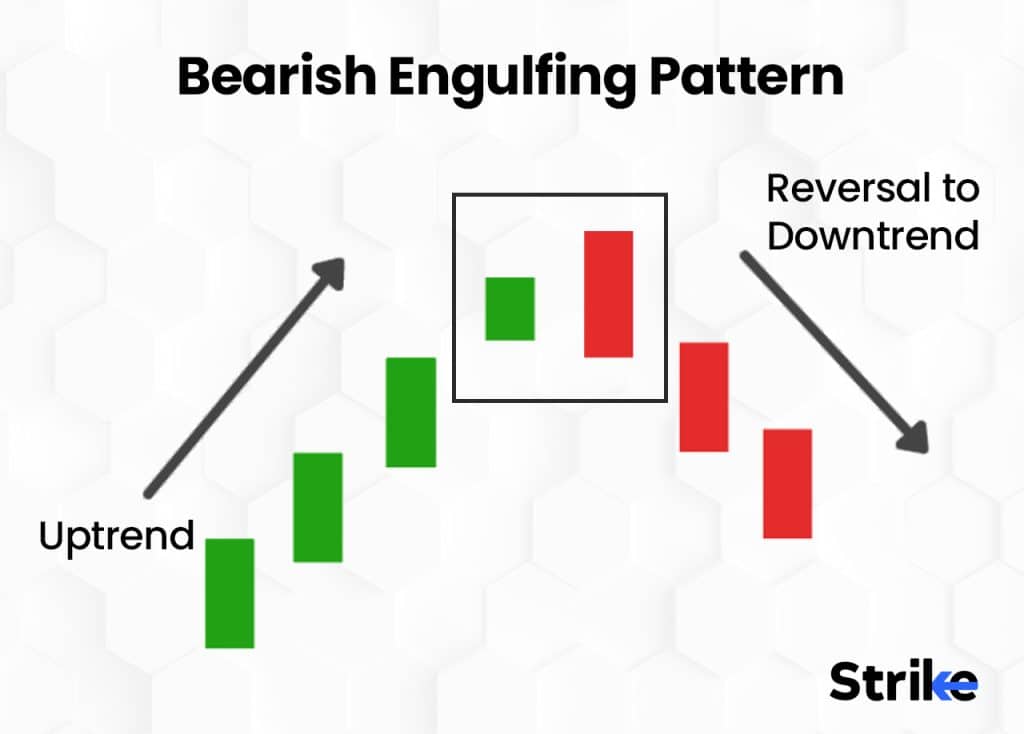
It is more significant if it occurs after a price advance and has less significance in choppy markets. This pattern has greater reliability when the open price of the engulfing candle is well above the close of the first candle, and when the close of the engulfing candle is well below the open of the first candle. Traders wait for the second candle to close, before acting on the pattern and then take action on the following candle. Both the candles are of substantial size relative to the price bars around them.
A bearish engulfing pattern is seen at the end of upward price alterations. Brilliant traders consider the overall picture when using bearish engulfing patterns. The uptrend is very strong and it is not wise to take a short trade. The price has some pullback when the overall trade is down.
The bearish engulfing pattern on the S&P 500 in October 2007 opened with a bullish pattern and closed with a bearish pattern that completely engulfed the pre candle body. This is a perfect example of a bearish engulfing pattern. The bearish engulfing pattern provides good shorting opportunities because the trade aligns with the longer term downtrend.
4.Bullish Engulfing Pattern
A Bullish engulfing pattern occurs after a price move lower and signals that the higher price to come. The Bullish engulfing pattern is a white candlestick that closes higher than the previous day’s opening after opening lower than the previous day’s close. It appears in a downtrend and is the combination of one dark candle and then a large hollow candle.
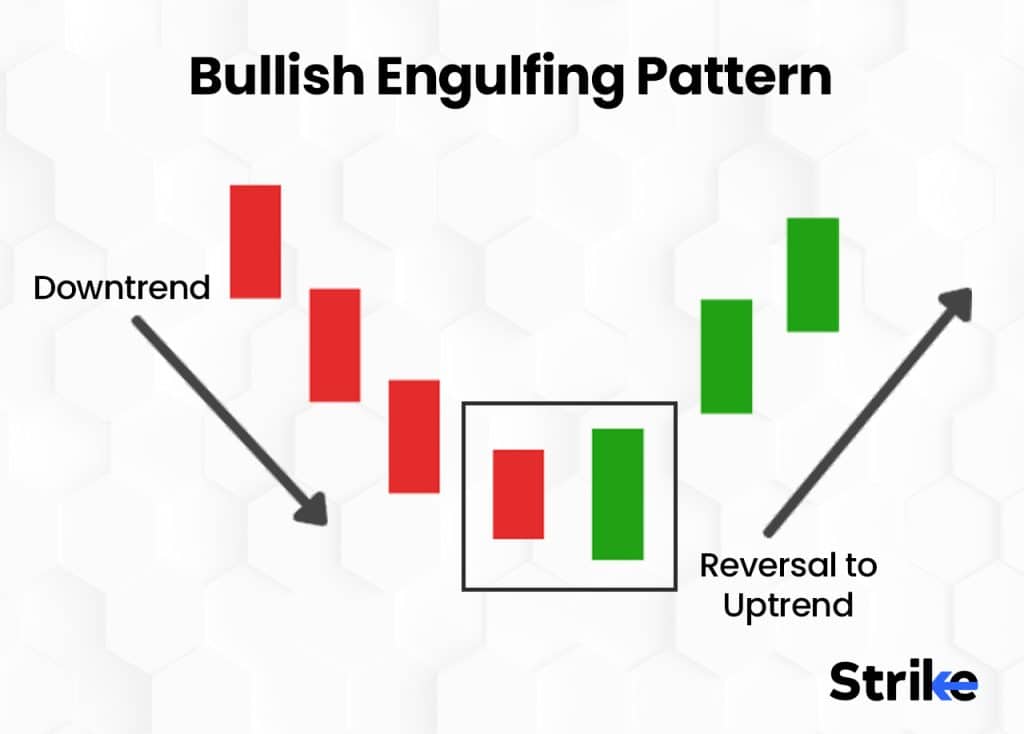
This engulfing pattern is identified as the small black candlestick shows a bearish trend. The next day a large white candlestick shows a bullish trend and the body of the previous day’s candlestick is completely engulfed. The bullish pattern forms when the stock must open at a lower price on Day 2 than it closed on Day 1.
The body of the white candlestick will not have a chance to engulf the body of the previous day’s black candlestick if the price did not gap down. The traders want to know whether a bullish engulfing pattern shows a change of sentiment which is a good time to buy the stocks. A bullish engulfing pattern occurred on January 13, 2012, and the price jumped from an open of $76.22 and closed out the day at $77.32.
This bullish day dominated the prior day’s daytime range where the stock finished down marginally. This move signals that the bulls are still alive and another wave in the uptrend could occur. This is a historical example of a bullish pattern. A bullish engulfing pattern is a powerful indicator when combined with the current trend.
5. Kicking Pattern
Kicking pattern is a reversal signal that happens in the beginning of a trend, during a trend, and at the end of the trend. This pattern occurs when two candles have large real bodies with one opening above the previous day’s high and the other opening below the previous day’s low. It is characterized by a sharp reversal in price over the range of two candlesticks.
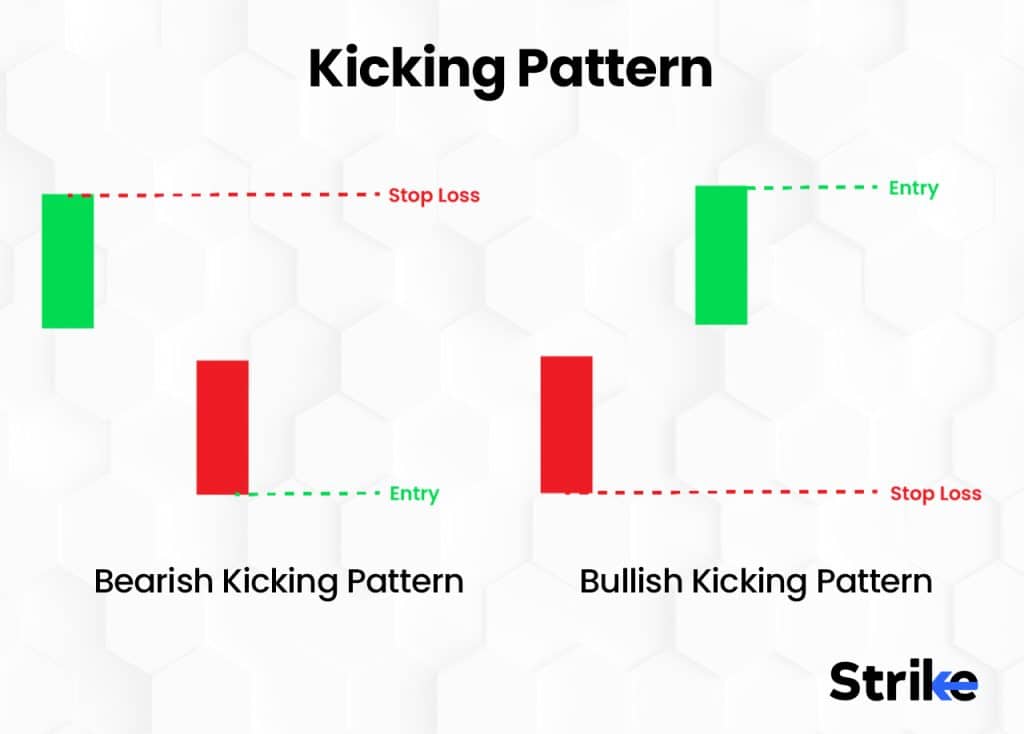
The traders use this pattern to determine which group of market participants is in control of the direction. This pattern points to a strong change in investors’ attitude towards a security that follows the release of valuable information about a company. The pattern looks similar, but each implies something different. Kicking patterns are either bullish or bearish.
Bullish kickers begin with a bearish candle and then signal bullish gap up. The opening price of the bullish candle is above the high of the previous day, showing a sudden shift in market sentiment from bearish to bullish. Bearish kickers start with a bullish candle and then indicate a bearish gap down. The opening price of the bearish candle is below the low of the previous day, indicating a sudden shift in market sentiment from bullish to bearish.
The kicking pattern is a rare and powerful reversal pattern and it is the strongest reverse signal in candlestick charting. The pattern is considered as the most reliable reversal pattern and indicates a dramatic change in the company’s fundamentals.
6. Bullish Harami Line
The bullish harami line is a double candlestick pattern that forms during a downturn and indicates a potential reversal in market direction. The bullish harami line generally indicates the small increase in price. It is a chart indicator proposing that a bearish trend will be coming to end.
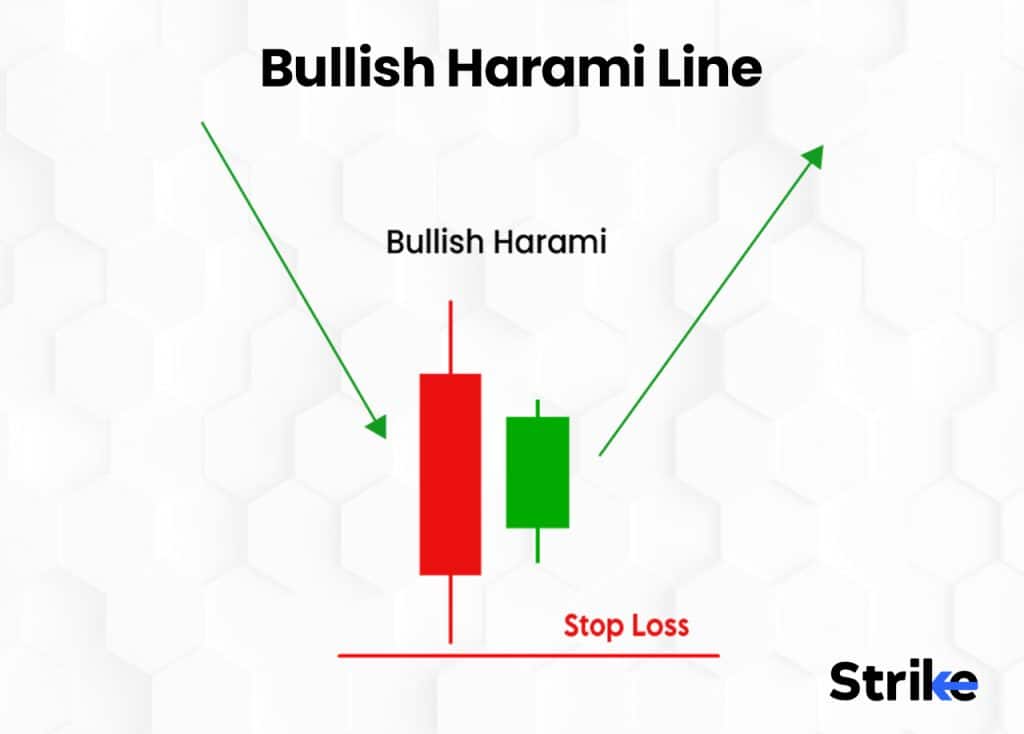
The Bullish harami line consists of a bearish candle with a large body and a bullish candle with a small body encircled within the body of the prior candle. The small bullish candlestick depicts a period of hesitation in the market, and its position within the previous day’s body signals that the bears are losing momentum and the bulls are starting to attain control.
Investors need to identify harami patterns by first looking for daily market performance reported in candlestick charts. The bullish harami line is examined to be a relatively weak reversal pattern, and it should be confirmed by other technical signals before traders make any trading decisions. The bullish harami line is a useful tool for traders who are looking for potential trend reversals in the market.
7. Piercing Line Patterns
The Piercing line pattern is a bullish reversal pattern that appears on candlestick charts. It is one of a few important candlestick patterns that technical analysts spot on a price series chart. The pattern is formed by two consecutive candles, the first candle is a bearish candle and the second one is a bullish candle that opens below the low of the previous candle but closes above its midpoint.
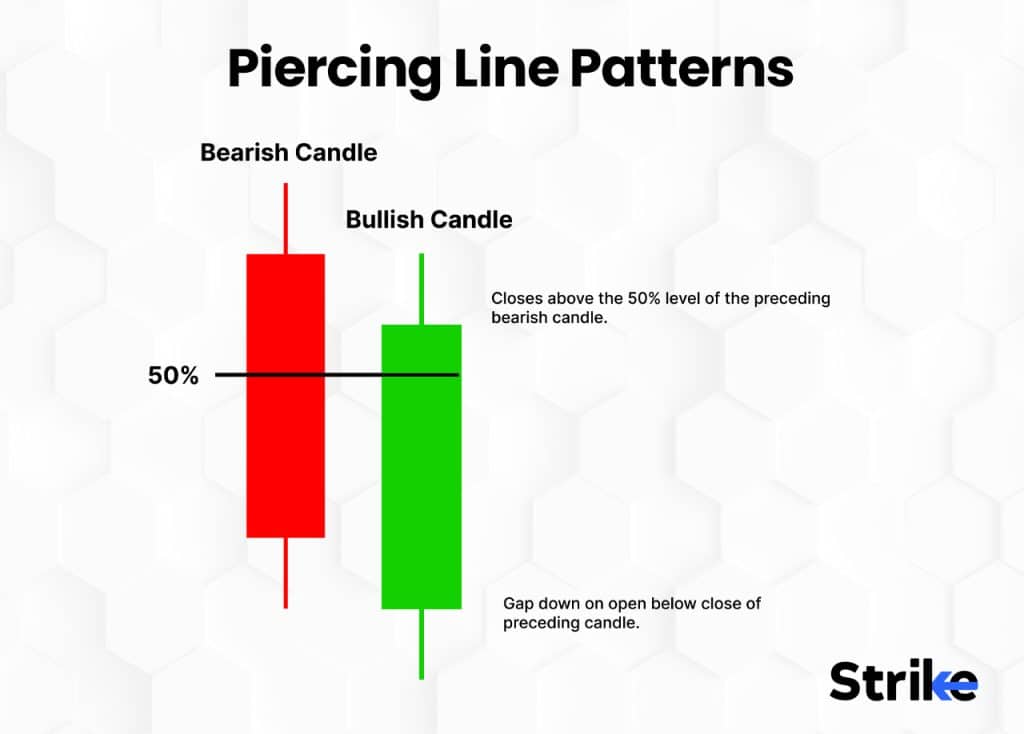
The first candlestick is probably dark in color and the second is light colored, signifying a day that closes higher than it opened. The pattern is important because it shows the market sentiment has changed from bearish to bullish. The first bearish candle suggests the seller is in control and the second candle indicates that the buyers take control, showing a possible trend reversal.
It also includes a gap down after the first day where the second day begins trading, opening near the low and closing near the high. The close is a candlestick that covers half of the upward length of the previous day’s red candlestick body. The piercing line pattern is similar to the dark cloud cover, the only difference is that dark cloud cover indicates a bearish reverse and the piercing line stream signals a bullish reversal.
8. Dark Cloud Cover
The Dark cloud cover is a candlestick pattern that indicates a shift in momentum to the downside following a price rise. The pattern is a reversal pattern in which a bearish downtrend follows a bullish uptrend. It is formed of two consecutive candles, the first candle is a bullish candle and the second is bearish candle that opens above the high of the previous candle but closes below its midpoint and the trend is continued, thus it predicts the fall in prices.
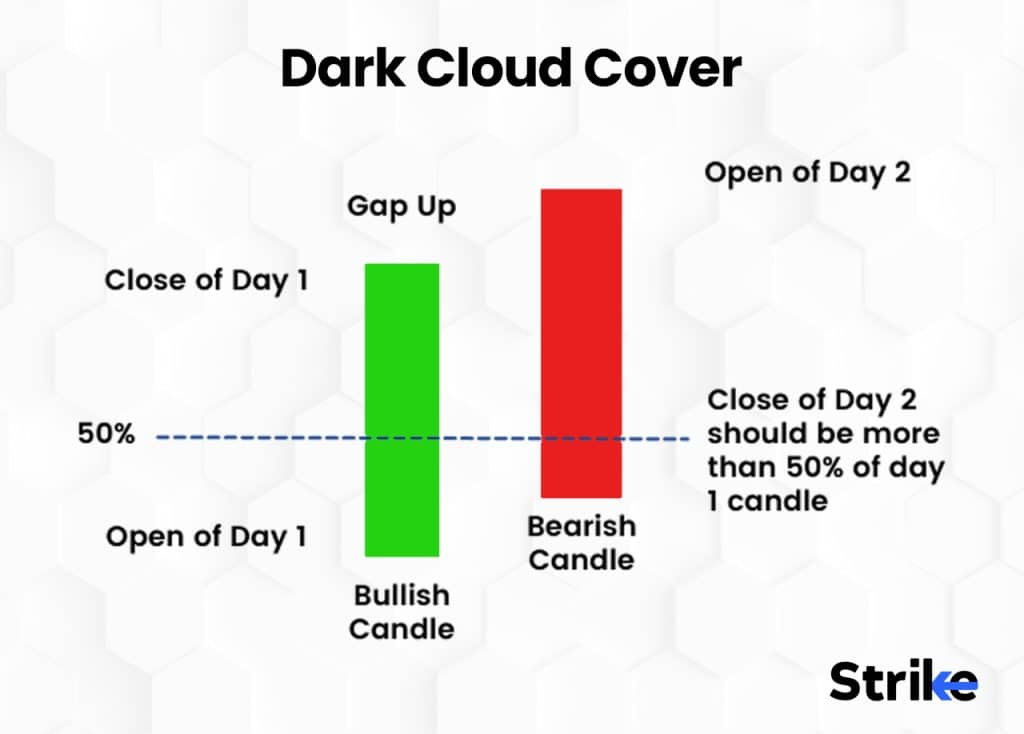
Both the candles are relatively large that shows strong participation of traders and investors. The bearish candle closes below the midpoint of the previous bullish candle. It is less significant when the pattern occurs with small candles. Dark cloud cover is a stock market event that elaborately studies the prices.The term ideally means that the collapse prices resemble dark clouds.
A Bearish dark cloud cover starts with an asset price that has been increasing for some time and then suddenly takes a turn and then falls consequently. This is the bearish reversal. Most of the traders consider the dark cloud cover pattern is useful as it occurs following an uptrend in price.
9. Bearish Harami Line
The Bearish harami line is a bearish reversal pattern that indicates a potential reversal of an uptrend. A Bearish harami received the name from japanese the word Harami means pregnant. The pattern is formed by a small bearish candlestick that is completely engulfed by the body of the preceding bullish candlestick.
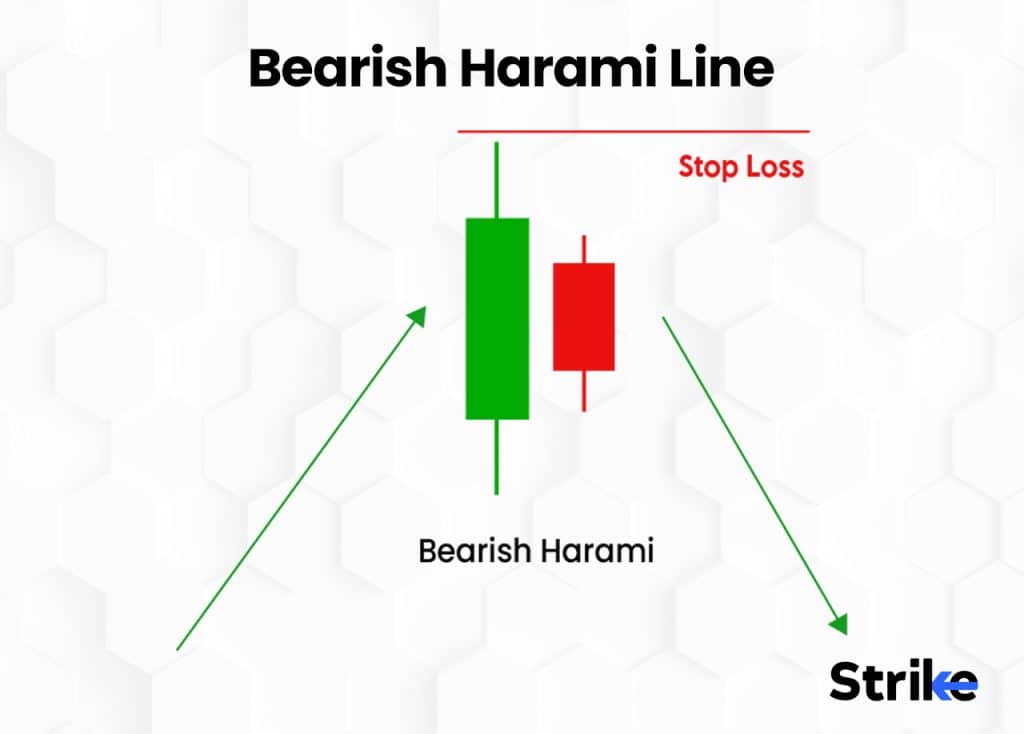
The bearish harami line shows the buying momentum that was driven by the uptrend is starting to weaken and that there will be a shift in sentiment among traders. The pattern consists of a long white candle followed by a small black candle. The opening and close prices of the second candle must be included within the body of the first candle. The candlestick chart indicates reversal in a bull price movement.
Traders use technical indicators such as relative strength index (RSI), stochastic oscillator with the bearish harami to increase the chance of a successful trade. A short position could be opened when the pattern forms and it signals an excessive buying. It is very significant to note that no signal candlestick pattern should be relied upon as the sole basis for a trading decision.
10. Matching Low
The Matching low is a double candlestick bullish reversal pattern that shows on candlestick charts. A matching low pattern belongs to the least frequency occurring on the charts. This pattern occurs after a price decline and indicates a potential bottom.The price goes either direction following the pattern and then it continues to the downside.
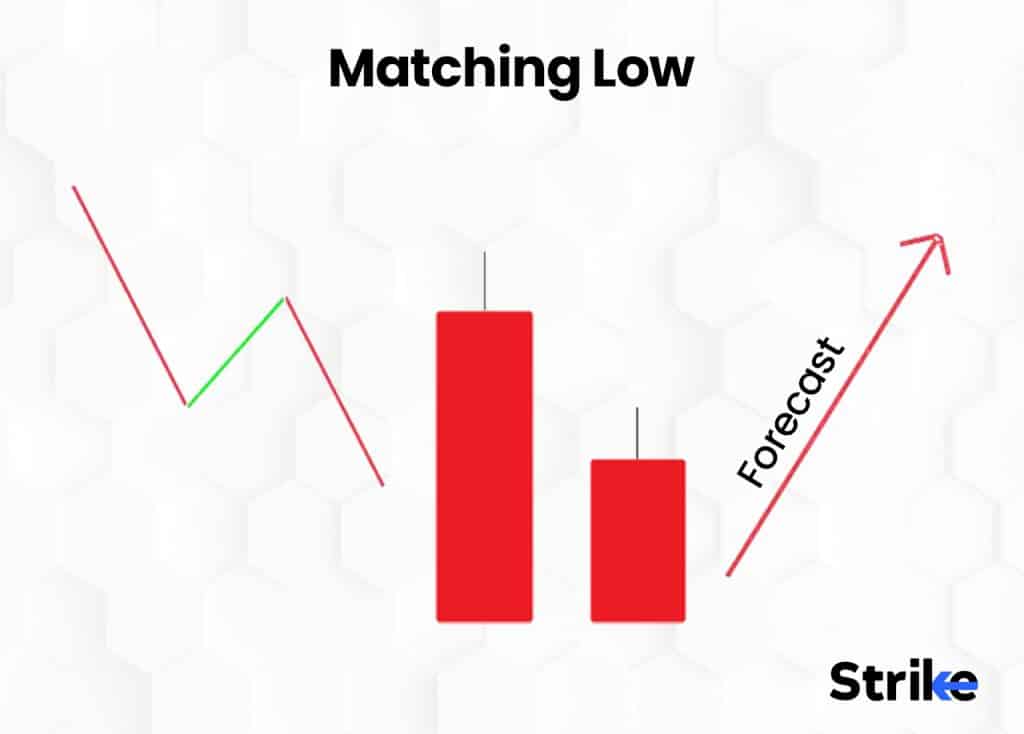
The first candle has a long black real body and the second candle also has a black real body that closes at about the same price level as the close of the first candle that indicates less selling pressure. This suggests that the bearish trend is losing momentum and then the buyers are starting to step in. The pivotal point is where both the candles exhibit similar closing prices despite the low shadows.
Traders could look for a rebound in the price following the matching low pattern while using the prior day’s close as a support level for the position. The pattern aids traders to anticipate the direction in which the market is moving- same or opposite. The whole theory of the matching low pattern is about bulls and bears making their moves and trying to take control over one another.
What is the most powerful double candlestick pattern ?
One of the most powerful double candlestick patterns is the Engulfing pattern used in technical analysis. The engulfing pattern confirms 67.3% of the time on average overall of all the 4120 markets analyzed from the research of trading view. The engulfing candles are mostly used as a candlestick to determine if the market is experiencing downward or upward pressure.
Candles in this pattern indicate a reversal in the current trend. The engulfing candle pattern can either be bearish or bullish depending on its location in the current trend. A Bullish engulfing pattern is formed when a small bearish candlestick is followed by a large bullish candlestick that completely engulfs the previous candlestick. The buyers took control of the market and led to a bullish reversal in this pattern. A bearish engulfing pattern is quite opposite to a bullish pattern.
The sellers have taken control of the market and lead to bearish reversal. Both the bullish and bearish engulfing patterns are considered powerful because they indicate a strong shift in sentiment and can indicate a potential trend reversal. These patterns are easy to identify on a chart and are widely used by traders and analysts to make trading decisions.
How to use double candlestick patterns in technical analysis ?
Double candlestick patterns are used in technical analysis to identify trade entry, exit points, and potential trend reversals. The candlestick patterns aren’t necessarily a buy or sell signal by themselves, but instead a way to look at the market structure and a potential indication of an upcoming opportunity.
Like any other market analysis tool, double candlestick patterns are most useful when used in combination with other techniques.
There are mainly 5 steps to using double candlestick patterns in technical analysis.
1. There are eight main double candlestick patterns including the bullish and bearish engulfing patterns, the morning and evening star patterns, the harami patterns, and the tweezer patterns, identifying the pattern on the chart to determine its bullish or bearish intimation.
2. It is very significant to confirm the double candlestick pattern with other technical indicators, which helps to strengthen the analysis.
3. Evaluating the trend direction of the underlying security to better understand the importance of the double candlestick pattern.
4. Consider the timeframe such as daily, weekly, or monthly charts that an investor analyzes when using the double candlestick pattern.
5. Traders will use the double candlestick pattern after identifying and confirming it as an indicator to enter or exit the position
Double candlestick patterns are useful tools in technical analysis but it’s important to use them in concurrence with other technical indicators and analysis methods to confirm their validity and make informed trade decisions.
How does double candlestick patterns used in trading ?
Traders use double candlestick patterns in different ways depending on their trading style and strategy. A double candlestick depicts the battle between buyers and sellers over a given period of time. The relationship between the open and close is considered vital information and forms the essence of candlestick.
It consists of two consecutive candles with specific shapes that can indicate a potential trend reversal. Bullish engulfing and Bearish engulfing are the most common double candlestick patterns in trading. The main advantage of this pattern is that they can provide clear indication of where the market is headed. The bullish pattern indicates the market is going to move higher while the bearish pattern shows that the market is moving lower.
The pattern can provide a strong confirmation signal to enter a long position because they are used to confirm other technical indicators. The double candlestick is useful in trading so that they show open, close, high and low price points.
What indicators are best with double candlestick patterns ?
Double candlestick charts are one of the most used technical tools to examine the price patterns. It is used by investors and traders to find patterns that indicate where the price is headed. Traders use indicators with double candlestick patterns to validate their signals.
There are mainly 5 indicators used :
- Relative Strength Index (RSI) helps traders to identify oversold conditions in the market which can refute signals from double candlestick patterns.
- Fibonacci retracement identify potential level of support and resistance which confirm signals from double candlestick patterns
- Moving averages helps to confirm the direction of the trend suggested by the double candlestick pattern
- Bollinger Bands also help to identify potential support and resistance levels.
- Volume confirms the strength of the signals from the double candlestick patterns. Higher volume can suggest stronger signals and vice versa.
Traders should use multiple indicators and perform through analysis before making any trade decisions.
Does Relative Strength Index (RSI) work well with double stick patterns ?
Yes, The Relative strength index is a popular technical indicator formed by combining candlestick patterns, increasing the odds of a successful reversal trade setup. Traders can use RSI to confirm whether the price is oversold when the double candlestick pattern occurs.
RSI is used in conjunction with double candlestick patterns to confirm their signals. Using RSI divergence to find exhausted trends to improve the probability of a reversal trade.
Are double candlestick patterns profitable ?
Yes, Double candlesticks patterns are profitable when they are used correctly in the right market conditions. The pattern provides traders with valuable information about continuations in the price movements. Traders should use a double candlestick pattern in combination with other technical indicators and perform through analysis of the market conditions to make it more profitable.
They should correctly use risk management techniques such as setting stop-loss orders, to manage their positions and minimize losses. So double candlestick patterns are profitable in trading and marketing.
Are double stick patterns reliable ?
Yes, double stick patterns are reliable signals that help traders to predict the future prices of a commodity, security, or currency pair. Double candlestick patterns are more reliable than single candlestick patterns.
The pattern depends on 4 factors such as the strength and clarity of the pattern, the market conditions in which it appears, and the presence of other confirming technical indicators. Bullish engulfing pattern and bearish engulfing pattern are considered to be more reliable than others due to their strong signals.
Are double candlestick patterns bullish or bearish ?
The double candlestick is either bullish or bearish depending on their pattern and its context within the market. The bullish engulfing pattern, tweezer bottom pattern are considered to be bullish reversal patterns that signal the market sentiment is shifting from bearish to bullish.
The bearish reversal patterns, tweezer top patterns are considered to be bearish reversal patterns showing market sentiment shifting from bullish to bearish.




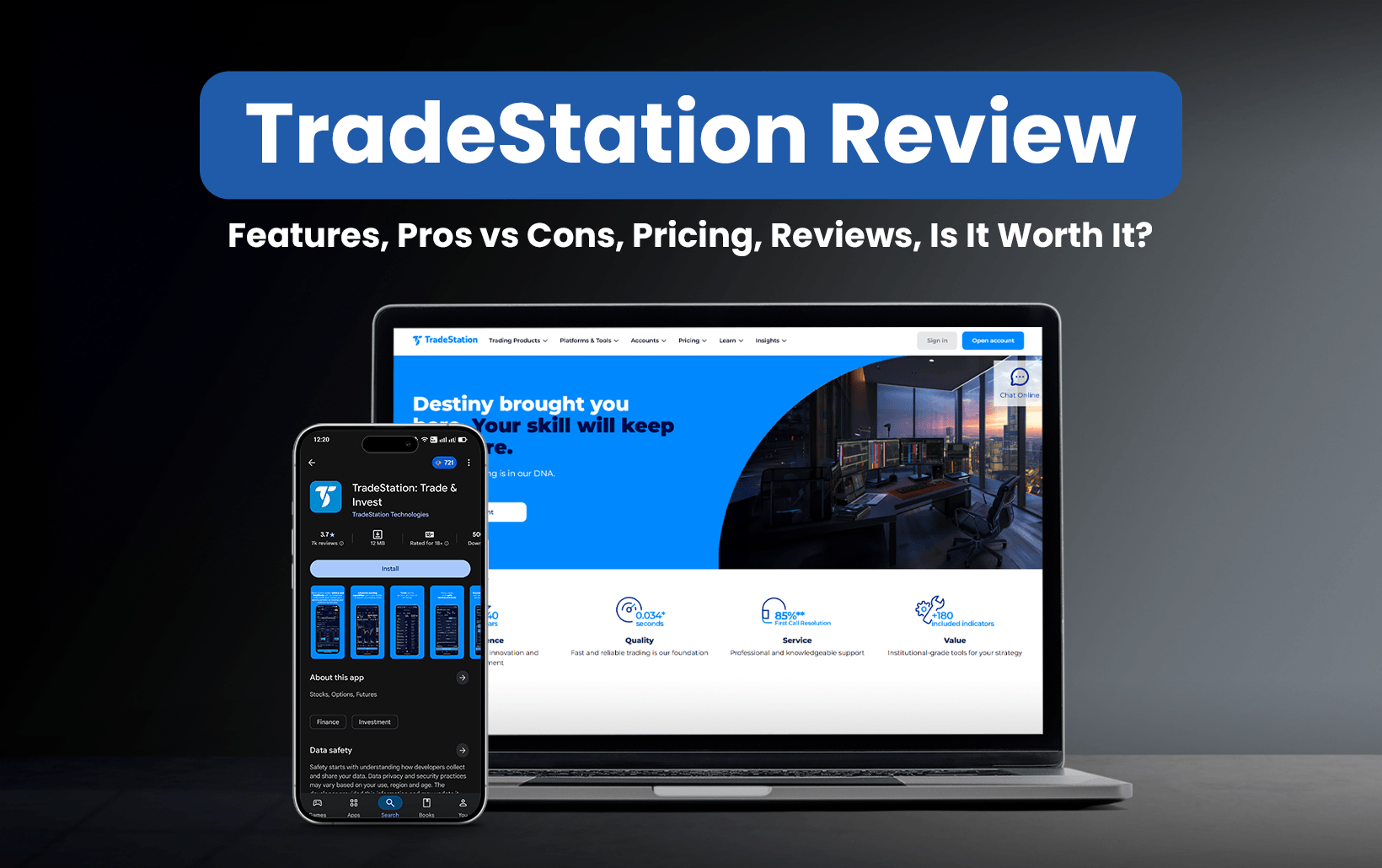
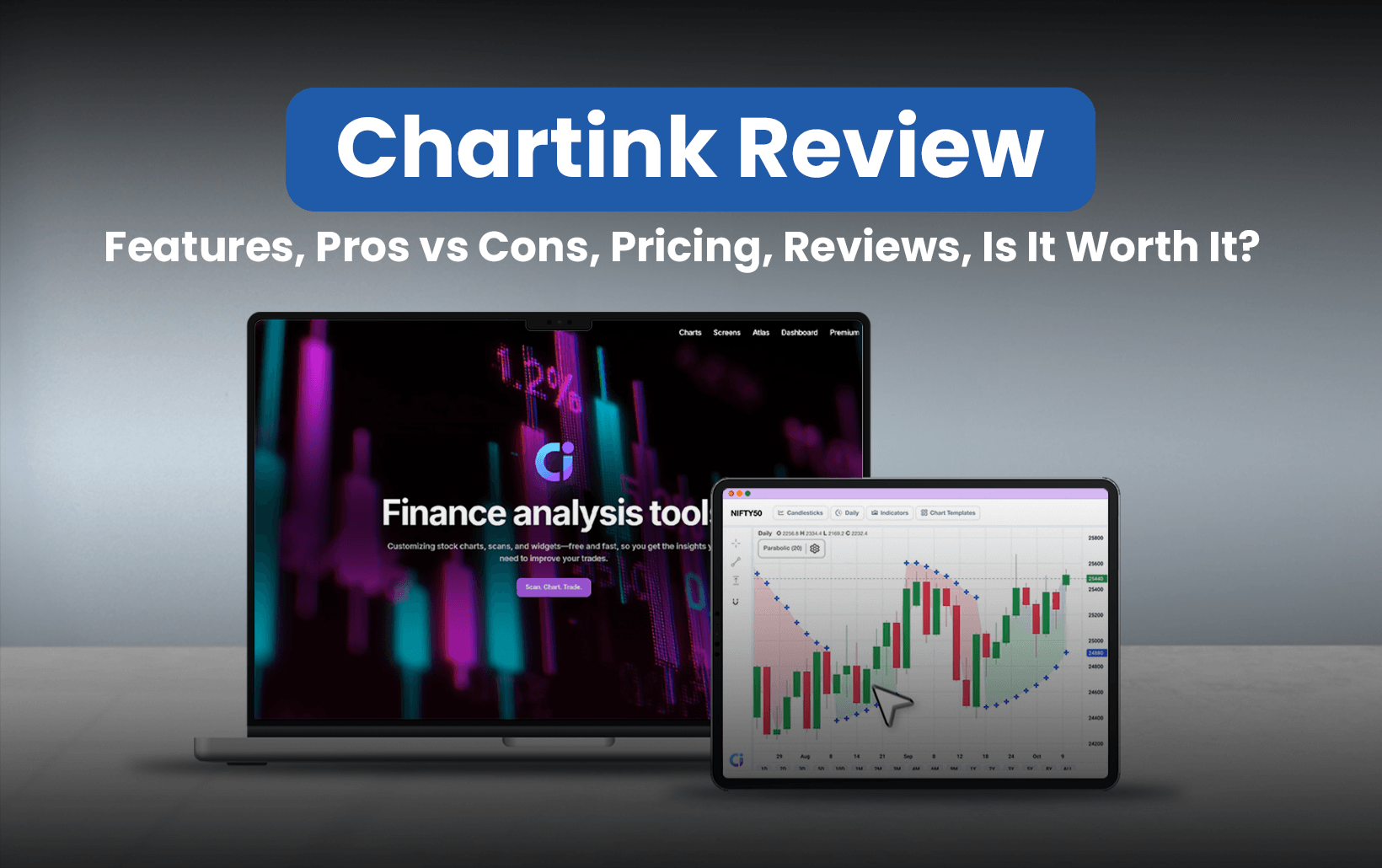


![85 Common Stock Market Terminologies for Dummies [Updated List for 2026] 67 85 Common Stock Market Terminologies for Dummies [Updated List for 2025]](https://www.strike.money/wp-content/uploads/2025/04/Popular-Stock-Market-Terms-for-Beginners-Banner.png)





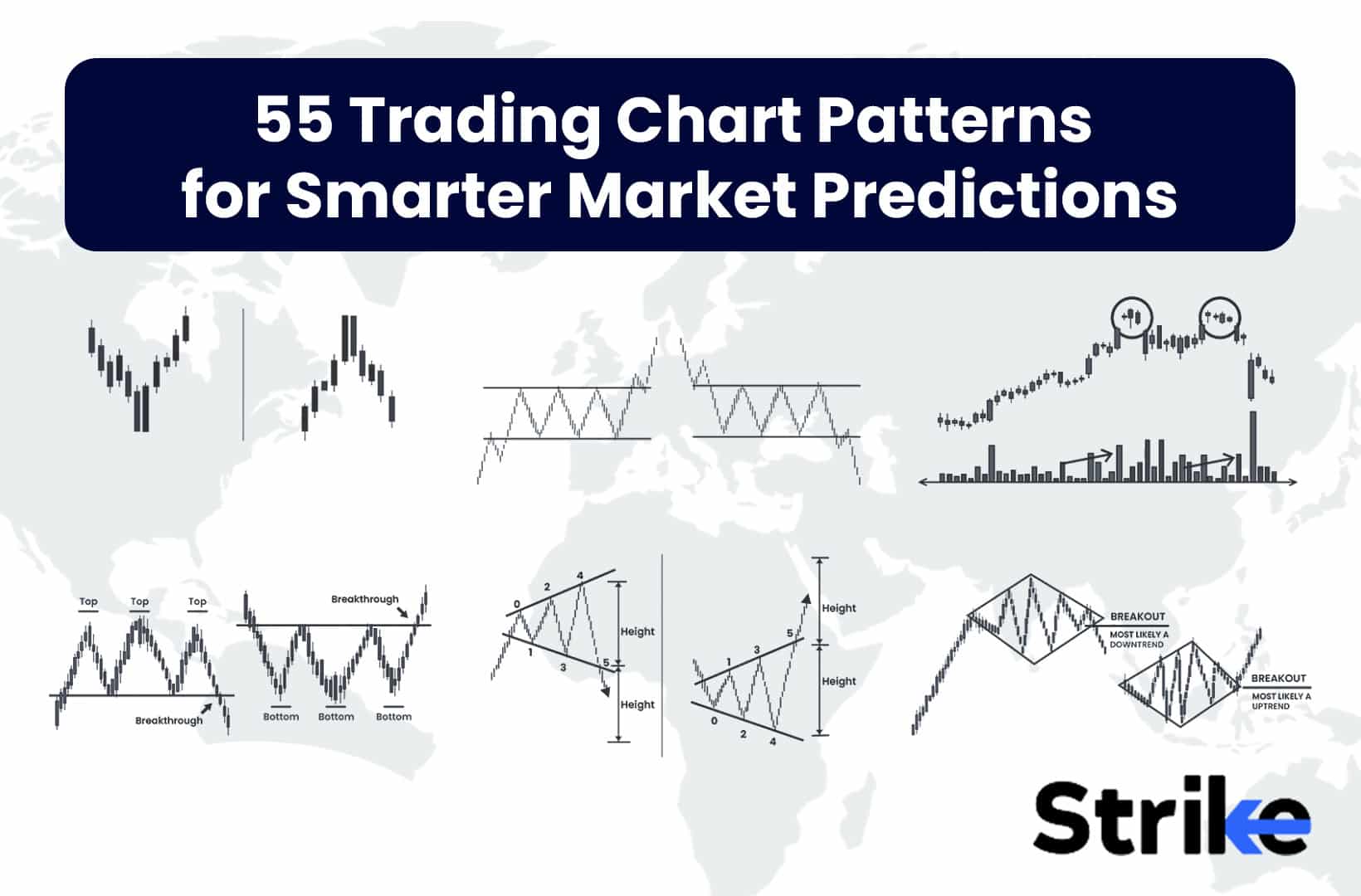





No Comments Yet.